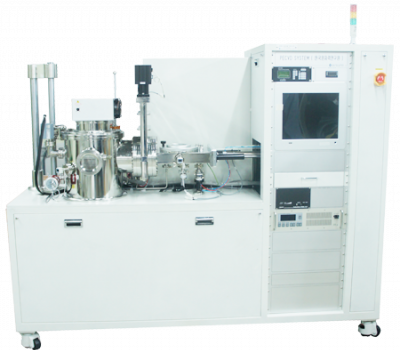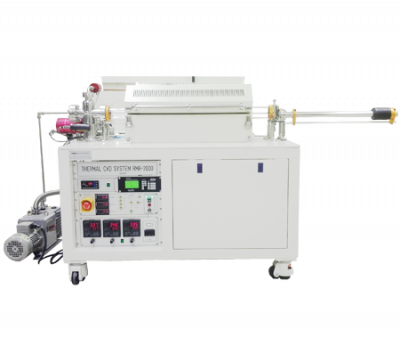-
제품 정보
제품 상세설명
Overview
Korea Vacuum Tech, Ltd. (KVT) is proud to introduce the latest revolutionary addition
to our product line, the CVD system. Chemical Vapor Deposition is a chemical reactive
process used to produce high-purity, high-performance solid materials in a vacuum state.
In a typical CVD process, the wafer (substrate) is exposed to one or more volatile precursors
which react and / or decompose on the substrate surface to produce a desired deposit.
Plasma Enhanced Chemical Vapor Deposition (PECVD) is a unique form of the CVD
process used primarily to deposit thin films from a gaseous state (vapor) to a solid state
on some substrate. PECVD is not dependent upon thermal energy alone to create of
maintain a chemical reaction but rather it uses RF-enhanced glow discharge to convey
energy to a reactive gas which subsequently, in a vacuum environment, sets the
conditions necessary for effective thin film deposition.
Features
≻ Compared to other CVD application, PECVD allows for operations in
a high-vacuum, low-temp environment
≻ Specially designed gas shower head provides uniform gas flow – consistent
film thickness over a surface
≻ Can distribute multiple gases, independently about the substrate and mixed
outside of gas shower head
≻ Semi – or Fully- Automate processing available
≻ Capable of multi-layer, co-deposition processing
≻ High deposition rates-fast!
Overview
Korea Vacuum Tech, Ltd. (KVT) is proud to introduce the latest revolutionary addition
to our product line, the CVD system. Chemical Vapor Deposition is a chemical reactive
process used to produce high-purity, high-performance solid materials in a vacuum state.
In a typical CVD process, the wafer (substrate) is exposed to one or more volatile precursors
which react and / or decompose on the substrate surface to produce a desired deposit.
Plasma Enhanced Chemical Vapor Deposition (PECVD) is a unique form of the CVD
process used primarily to deposit thin films from a gaseous state (vapor) to a solid state
on some substrate. PECVD is not dependent upon thermal energy alone to create of
maintain a chemical reaction but rather it uses RF-enhanced glow discharge to convey
energy to a reactive gas which subsequently, in a vacuum environment, sets the
conditions necessary for effective thin film deposition.
Features
≻ Compared to other CVD application, PECVD allows for operations in
a high-vacuum, low-temp environment
≻ Specially designed gas shower head provides uniform gas flow – consistent
film thickness over a surface
≻ Can distribute multiple gases, independently about the substrate and mixed
outside of gas shower head
≻ Semi – or Fully- Automate processing available
≻ Capable of multi-layer, co-deposition processing
≻ High deposition rates-fast!
-
Specifications
제품 Specifications
Specifications
ITEM
SPECIFICATIONS
Process Chamber
Material : SUS304 / Anodized Al6061
Loadlock Chamber
N/A
Vacuum Pumping Station
TMP & Dry Pump
Gas shower Head
Shower Head with insulator/RF bias electrode isolation
Pressure Control
Auto Throttle Valve & CDG Sensor
Substrate Heating Type
- Heating element size: 4” ~ 6”
- Heating element type: SiC, Molded
Gas Supply Unit
Mass Flow Controller & valve
Plasma Source
RF generator with matching network
Process control
KVC-P4000
KVC-P4000L
KVC-P2000
KVC-P2000L
PC Control
By Labview
PC Control
By Labview
Semi-Auto
Semi-Auto
Specifications
ITEM
SPECIFICATIONS
Process Chamber
Material : SUS304 / Anodized Al6061
Loadlock Chamber
N/A
Vacuum Pumping Station
TMP & Dry Pump
Gas shower Head
Shower Head with insulator/RF bias electrode isolation
Pressure Control
Auto Throttle Valve & CDG Sensor
Substrate Heating Type
- Heating element size: 4” ~ 6”
- Heating element type: SiC, Molded
Gas Supply Unit
Mass Flow Controller & valve
Plasma Source
RF generator with matching network
Process control
KVC-P4000
KVC-P4000L
KVC-P2000
KVC-P2000L
PC Control
By Labview
PC Control
By Labview
Semi-Auto
Semi-Auto
-
Options
-
Control
제품 Control
System Control
Pumping
The figure shows the pumping screen. Pumping
screens have valves and pumps. The pump and valve
are easily operated with one touch.
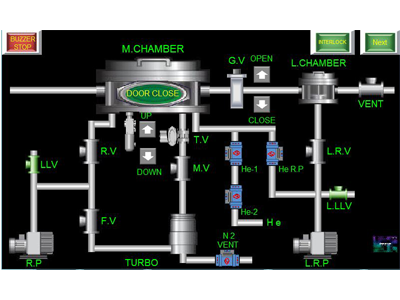
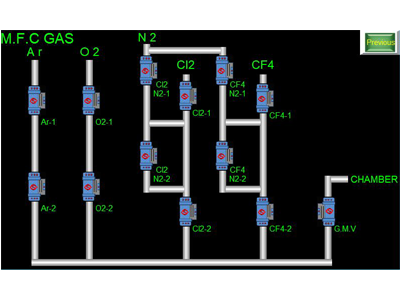
Gas Control
This picture shows the gas control screen.Interlock
This picture shows the interlock screen. Basically, the interlock is set so that it does not work when you deviate from the correct method of use for your safety.
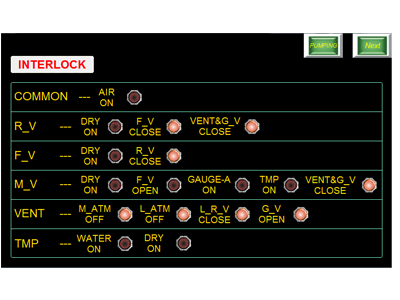
System Control
Pumping
The figure shows the pumping screen. Pumping
screens have valves and pumps. The pump and valve
are easily operated with one touch.


Gas Control
This picture shows the gas control screen.Interlock
This picture shows the interlock screen. Basically, the interlock is set so that it does not work when you deviate from the correct method of use for your safety.

-
사용후기
-
상품문의
-
배송/교환정보
[배송]
배송 안내 입력전입니다.[교환]
교환/반품 안내 입력전입니다.
선택된 옵션
-
KVC-P2000+0원

